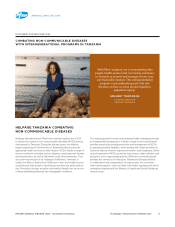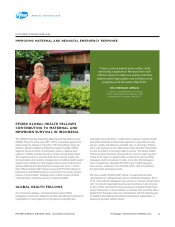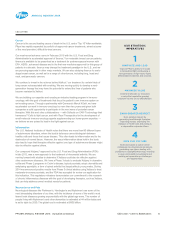Pfizer 2014 Annual Report Download - page 11
Download and view the complete annual report
Please find page 11 of the 2014 Pfizer annual report below. You can navigate through the pages in the report by either clicking on the pages listed below, or by using the keyword search tool below to find specific information within the annual report.
PFIZER ANNUAL REVIEW 2014 www.pzer.com/annual 11
ANNUAL REVIEW 2014
Cancer
Cancer is the second leading cause of death in the U.S. and a “Top 10” killer worldwide.
Pzer has rapidly expanded its portfolio of approved cancer treatments, aimed at some
of the most prevalent, difcult-to-treat cancers.
Our most recent advance came in February 2015 with the U.S. Food and Drug
Administration’s accelerated approval of Ibrance,® for metastatic breast cancer patients.
Ibrance is available to be prescribed as a treatment for postmenopausal women with
ER+, HER2-, advanced disease and is the rst new medicine approved for this group of
patients in a decade. Ibrance may change the treatment paradigm in the U.S., and we
are pursuing approvals in other major markets. We are also studying Ibrance for early-
stage breast cancer, as well as for a range of other tumors, including lung, head and
neck, and pancreatic cancers.
We continue to invest in the science behind Xalkori,® our treatment for certain kinds of
lung cancer not associated with smoking. We are moving quickly to develop a next-
generation therapy that may have the potential to extend the lives of patients who
become resistant to Xalkori.
We are building our expertise and creating an industry-leading program in immuno-
oncology, with the goal of treatments that focus the patient’s own immune system on
an invading cancer. Through a partnership with Germany’s Merck KGaA, we have
accelerated our work in immuno-oncology by more than two years and given both
companies a solid opportunity to participate in the next wave of potential cancer
therapies. With this and other collaborations — with Cellectis on CAR-T technology that
harnesses T-Cells to ght cancer, and with iTeos Therapeutics for the development of
small-molecule immuno-oncology agents supplementing our home-grown expertise —
we believe we are poised to lead in the ght against cancer.
Inammation
The U.S. National Institutes of Health notes that there are more than 80 different types
of autoimmune disorders, where the body’s defenses cannot distinguish between
healthy cells and those that cause disease. This often leads to inammation and to the
destruction of normal tissue. However, the ways inammation takes hold in the body
also lead to hope that therapies effective against one type of autoimmune disease might
also be effective against others.
Our compound Xeljanz,® approved by the U.S. Food and Drug Administration (FDA)
in late 2012, was a new approach to the treatment of rheumatoid arthritis. We are
moving forward with studies to determine if Xeljanz could also be effective against
other autoimmune diseases. We have a Phase 3 study to evaluate Xeljanz in ulcerative
colitis and Phase 2 programs in Crohn’s disease, topical psoriasis, atopic dermatitis and
ankylosing spondyltis, a form of spinal arthritis that largely affects young males. During
2014 we announced positive results from Phase 3 clinical studies using Xeljanz to treat
moderate-to-severe psoriasis, and the FDA has accepted for review our application for
this indication. This regulatory milestone demonstrates our commitment to the research
of chronic inammatory diseases with the goal of developing therapies, such as Xeljanz,
that can help address unmet medical needs for patients.
Neuroscience and Pain
Neurological diseases like Parkinson’s, Huntington’s and Alzheimer’s are some of the
most devastating disorders of our time, with the incidence of some of the world’s most
feared brain diseases growing exponentially with the global age wave. The number of
people living with Alzheimer’s and other dementias is estimated at 44 million today and
is set to triple by 2050. The global cost is estimated at $605 billion.
OUR STRATEGIC
IMPERATIVES
1
INNOVATE AND LEAD
Improve Pzer’s ability to innovate
in biomedical R&D and develop a
new generation of high value, highly
differentiated medicines and vaccines.
2
MAXIMIZE VALUE
Invest and allocate our resources
in ways that create the greatest
long-term returns for our shareholders.
3
EARN GREATER RESPECT
Earn society’s respect by
generating breakthrough therapies,
improving access, expanding the
dialogue on health care and acting as
a responsible corporate citizen.
4
OWN OUR CULTURE
Build and sustain a culture where
colleagues view themselves as owners,
generating new ideas, dealing with
problems in a straightforward way, investing
in open and candid conversations and
working as teammates on challenges
and opportunities.
CEO Letter > Letter to Stakeholders
CEO LETTER
























